Introduction
I've been watching nearly all of the steps of Microsoft's new Flight Simulator, as it has sounded like an unbelievable synergy of technology, real-time data, and next-gen graphics in what looked like the best Flight Simulator ever.
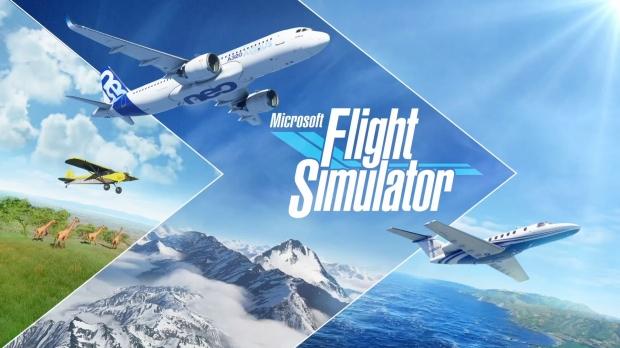
Well, it's now here -- and while it has had a troubled start, the game itself is an absolute treasure. It is truly one of the best looking games I've ever played, and has kick started a few weeks of playing, testing, and benchmarking Flight Simulator.
Graphics Engine
Flight Simulator was co-developed between Microsoft and Asobo Studio, running on the ACE (Asobo Conception Engine). It is on Windows for now, but will be on the Xbox One and Xbox Series X in the near future.
There's a funny story about how Flight Simulator came to be, as the foundations for the game started when Asobo was working on a product for Microsoft augmented reality headset, HoloLens. The project was called HoloTour, with the challenge of building a digital version of Machu Picchu's vast mountainside and vistas vs. normal buildings at street level, that would be displayed inside of the HoloLens.
Side note: Machu Picchu is a 15th-century Inca citadel, located in the Eastern Cordillera of southern Peru, on a 2,430-metre (7,970 ft) mountain ridge.
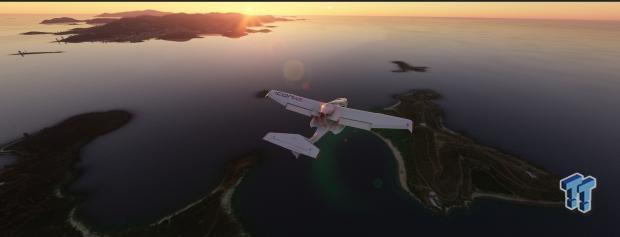
It was from there that Microsoft executive and project leader Jorg Neumann consulted with the team at Bing Maps to use their detailed photogrammetry data to build a flight demo for the city of Seattle. Neumann put the hours in, flying over the Switzerland to work with weather researchers to get their models and data into the project.
The best part of this is the story behind it, before it became Flight Simulator.
Neumann talked about an early build of Flight Simulator to Xbox head Phil Spencer: "Using data of Microsoft's home city of Seattle, which Bing Maps has rendered down to five-centimeter resolution with photogrammetry, Asobo took a few weeks to put together a demo of a Cessna flying downtown. Neumann then showed it to Phil Spencer, a VP at the time who is now the head of Xbox. "He just looked at me and said, 'Why are you showing me a video of Seattle with a plane?'" Neumann says. "And then the plane turned, and we flew over the Microsoft campus where we were sitting at that exact moment. And he's like, 'Is this real-time? Is this running?' And I'm like, 'Yes, it is!' And we knew then we had something special".
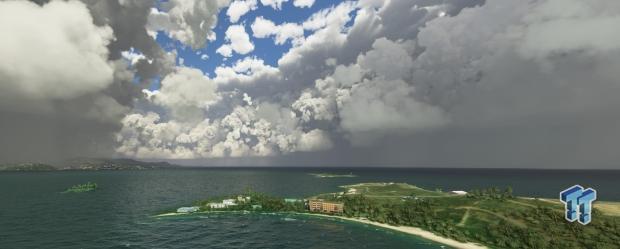
The Incredible World of Flight Simulator
At a technological level, Flight Simulator is nothing short of insanity. The game populates the world with animals, roads with vehicles driving on them, water flows in the direction it would in the real-world -- and by the direction of the wind.
The grass is rendered in individual grass blades at some points, while trees sport individual leaves.
- Flight Simulator has over 2 million cities and towns right now, with the living, breathing world filled with over 1.5 billion buildings, over 2 trillion trees, and 37,000 real-world airports. You will be able to fly over your house, if you can find it on Bing Maps right now, you'll be able to fly over it in Flight Simulator.
Microsoft is doing something truly next-generation with Flight Simulator, where most of this is being processed on the cloud -- on their in-house Azure servers. It is then beamed to your PC (and soon, Xbox) in real-time to provide you with one of the most 'alive' worlds I've ever seen.
There are real-world storms that you can watch as you fly by in a jetliner, with gigantic lightning storms over New York City never looking better. It is truly just amazing to sit there and watch lightning crack through clouds, no other weather system in a game has looked this good.
It is virtually photorealistic.
- It's all thanks to Adaptive Streaming technology: Microsoft and Asobo put in an incredible effort into the technologies that make Flight Simulator, but if you want the very best out of it you'll need a 50Mbps internet connection. The game will render parts of itself in the cloud, and then blast them down to you in real-time. The better the internet connection, the better quality the graphics are.
System Requirements
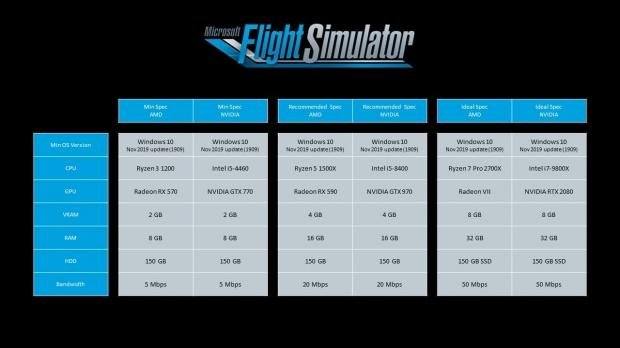

Graphics Cards Tested
I went into this thinking we'd be OK to test most of the highest-end graphics cards in Flight Simulator at 8K, but in the end we needed at least 16GB of VRAM. This eliminates virtually every graphics card on the market bar a few: so we have two, the NVIDIA TITAN RTX and Radeon VII.
- NVIDIA TITAN RTX (24GB GDDR6)
- NVIDIA GeForce RTX 2080 Ti (11GB GDDR6)
- AMD Radeon VII (16GB HBM2)
I kept the GeForce RTX 2080 Ti in and did try to lower the details to "Low" but we're only getting 2-3FPS, it's literally unplayable with anything less than 16GB of VRAM, minimum.
Test System Specs
I've got a new upgrade inside of my GPU test bed before my change to a next-gen test bed, where I will be preparing for NVIDIA's next-gen Ampere graphics cards (you can read more on that here) and AMD's next-gen RDNA 2 graphics cards (more on those here).
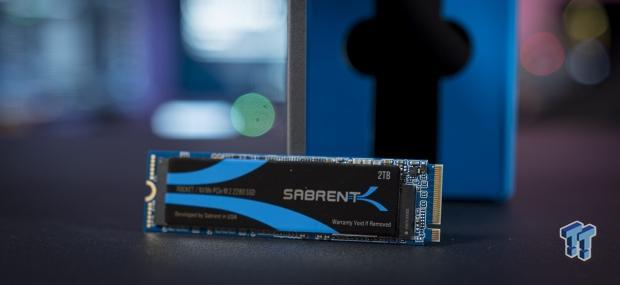
Sabrent helped out with some new storage for my GPU test beds, sending over a slew of crazy-fast Rocket NVMe PCIe M.2 2280 SSDs. I've got this installed into my GPU test bed as the new Games Storage drive, since games are so damn big now. Thanks to Sabrent, I've got 2TB of super-fast M.2 PCIe 3.0 x4 SSD storage now.
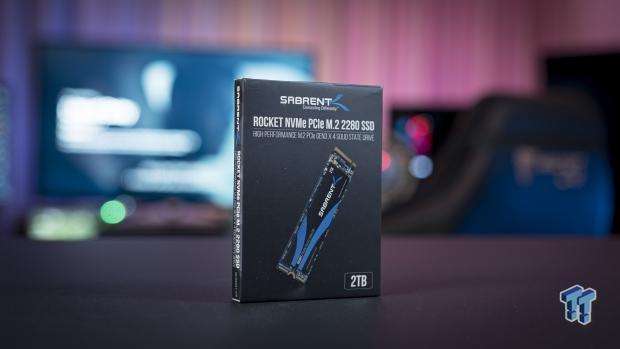
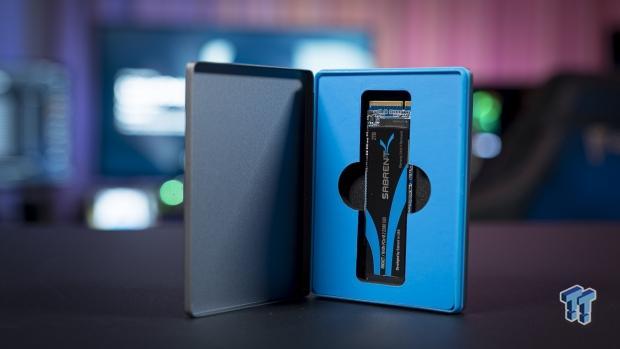
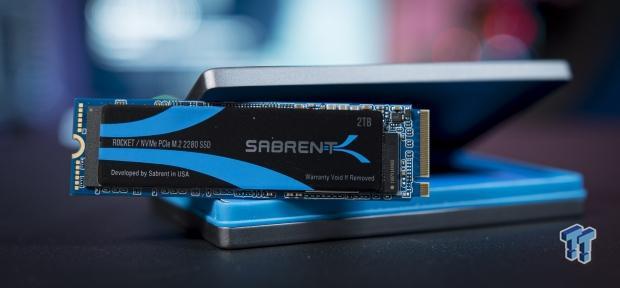
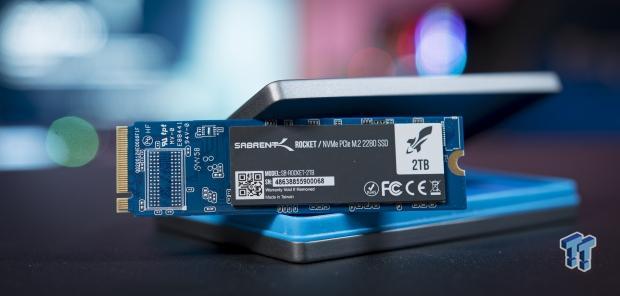
Anthony's Test System Specifications
- Motherboard: GIGABYTE Z370 AORUS Gaming 7 (buy from Amazon)
- CPU: Intel Core i7-8700K @ 5GHz (buy from Amazon)
- Cooler: Corsair Hydro Series H115i PRO (buy from Amazon)
- Memory: 16GB (2x8GB) HyperX Predator DDR4-2933 (buy from Amazon)
- SSD: Sabrent Rocket Q 2TB NVMe PCIe M.2 2280 (buy from Amazon)
- Power Supply: InWin 1065W
- Case: InWin X-Frame
- OS: Microsoft Windows 10 Pro 64-bit (buy from Amazon)
Additional Images
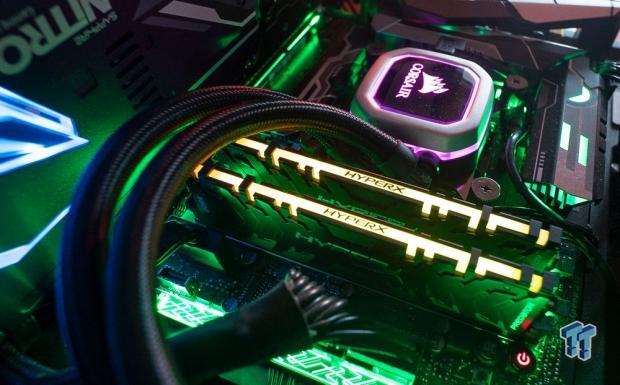
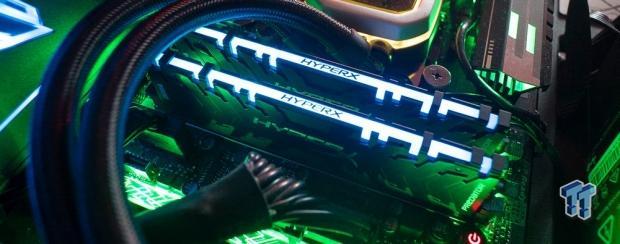
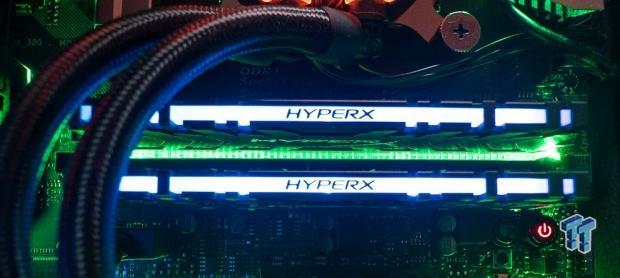
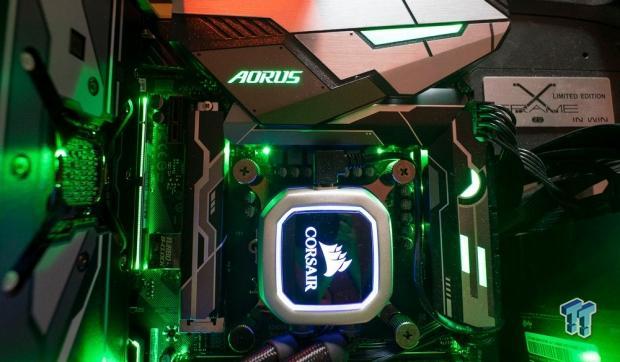
8K Resolution Explained
8K might just sound like double 4K, but it actually renders 4x the amount of pixels of 4K. 8K renders at 7680 x 4320 while 4K renders at 3840 x 2160. You'd need to have 4 x 4K monitors in order to have the same pixel count as an 8K monitor.
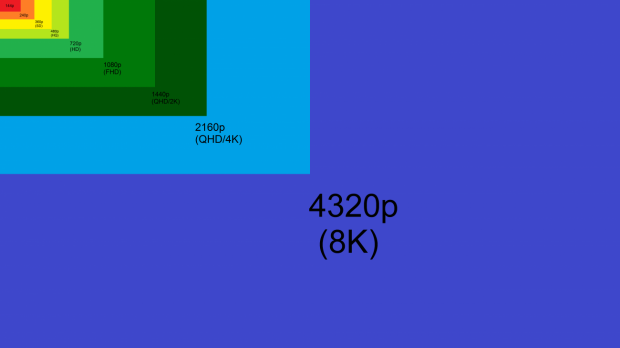
Dell's impressive UP3218K is a huge 32-inch monitor with a native resolution of 7680 x 4320, which when sitting in front of it, feels like it's almost perfect.
This is the monitor we're using in-house at TweakTown for 8K benchmarking, and as you can see from this handy image, 1080p is super small compared to 4K - and absolutely tiny compared to 8K. Looking at the is-it-even-there resolution of 1280x720 that most console games run at (and now we're finally shifting into 1080p on consoles), 8K absolutely blows them away.
8K isn't easy -- and Flight Simulator makes that even harder.
- You're going to need a lot of VRAM, or a next-gen GPU: Because of the massive resolution, it was able to consume right up to 16-17GB of VRAM on the NVIDIA TITAN RTX graphics card. This is something that no matter what you do, unless you run 200% scaling, will ever happen to you at 4K or any other resolution.
- Yeah, you really need a next-gen GPU: No one is going to go out and buy a TITAN RTX for Flight Simulator at 8K right now. My advice, no my order is -- do not do that, just wait a few weeks and see if we do get a GeForce RTX 3090 graphics card with 24GB of ultra-fast GDDR6X memory. That is the card you'll want for Flight Simulator at 8K.
Graphics Quality Settings Used
I've got everything on the highest setting apart from anti-aliasing, which I've got disabled. Microsoft requires a 50Mbps internet connection for the "ideal spec" which I meet, as I have a 500Mbps pipe -- so that should provide me with plenty of bandwidth for the best possible experience -- at 8K.
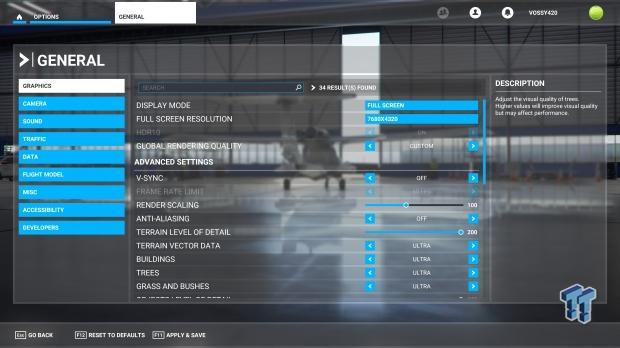
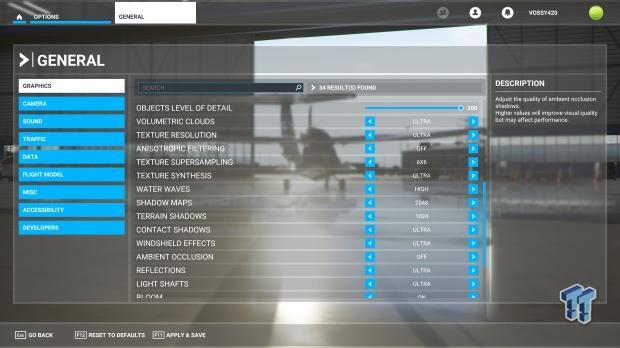
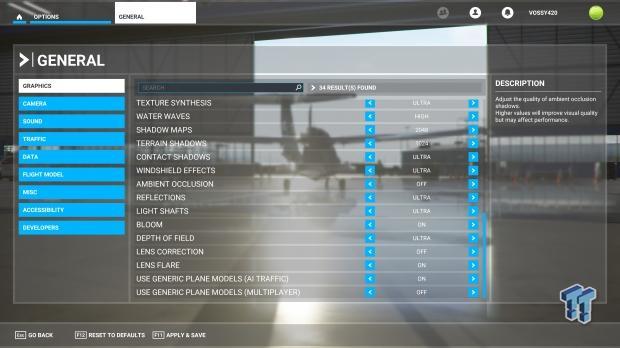
Where We Flew
I live in Gawler, South Australia -- so to totally nerd out, I took off from my local airport, Adelaide Airport. Heading out of Adelaide Airport, we flew north up towards Gawler where I live and landed at the Gawler Airport.
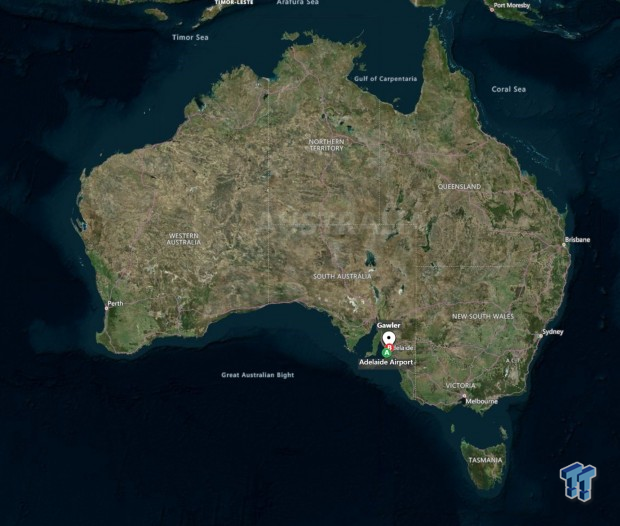
This is a map of Australia -- just to bring you up to speed, and more specifically where South Australia (and our route) is located.
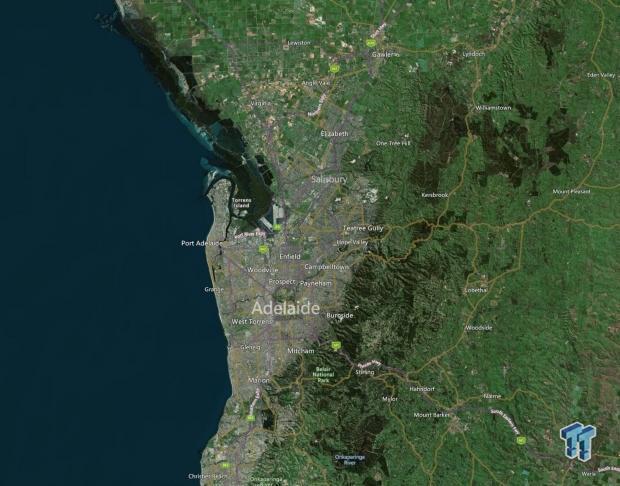
This is a map of metropolitan Adelaide, right up to Gawler -- where I live. This is the route we took, from just above where you can see West Torrens, right through to Gawler is the trip we made in Flight Simulator at 8K.
- Plane: ICON A5
- Departing airport: Adelaide Airport (South Australia, Australia)
- Arriving airport: Gawler Airport (Gawler, South Australia, Australia)
- Flight time: The flight time is around 16 minutes
- Time of day: 12:30PM (just after midday)
- Season: Winter
- Weather: Scattered clouds
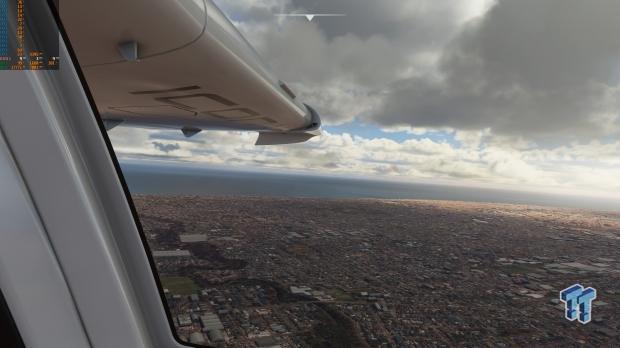
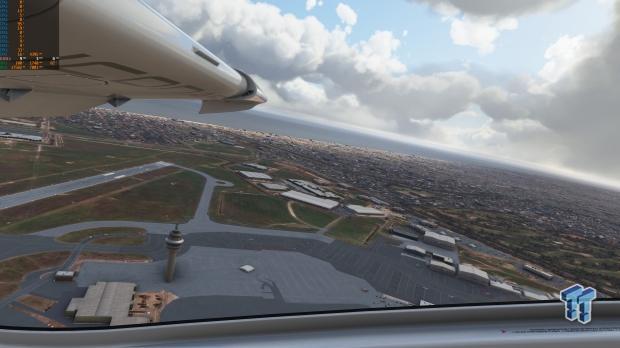
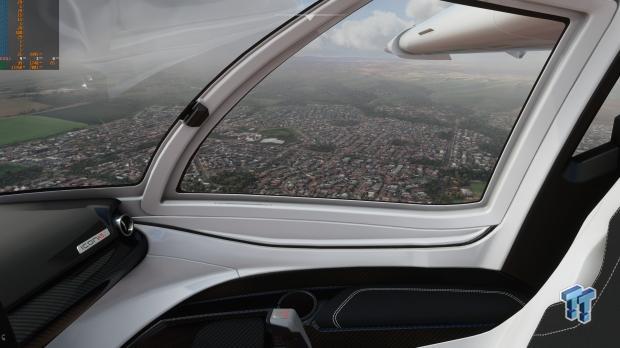
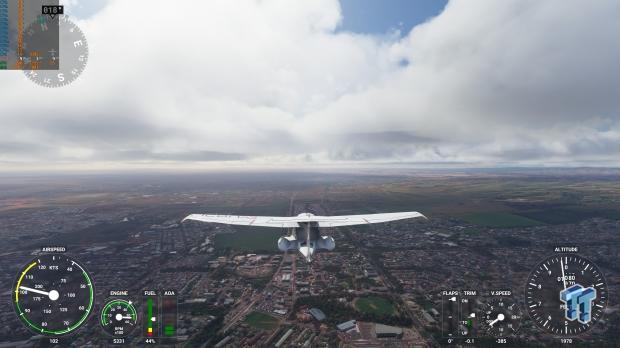
8K Benchmark Results
Note: Because there is no built-in benchmark for Flight Simulator, and everyone will depart and land at different airports with varying weather which would change results drastically, I'm doing a shorter trip to get more accurate results.
I will continue to test Flight Simulator, with different weather effects, larger (and smaller) planes, different locations and time of day. For now, this is a quick and dirty 8K benchmark flying a small distance in a smaller city, just to gauge how Flight Simulator performs at 8K and how much it crushes my test bed.
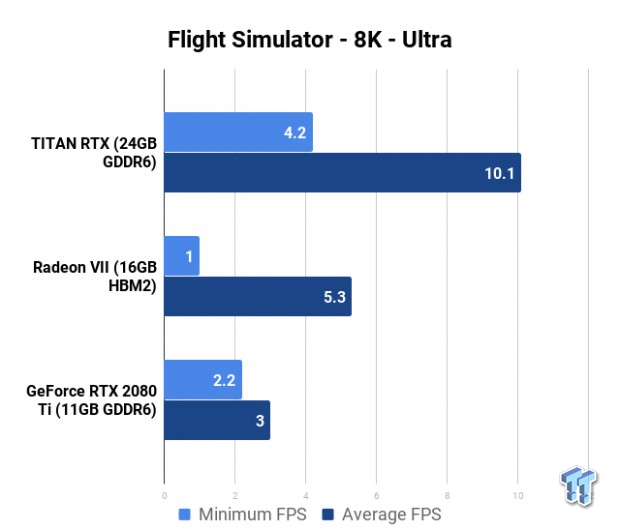
Performance Thoughts
I thought we'd be able to at least fire up the GeForce RTX 2080 Ti at 8K and get maybe 10FPS or so, leaving the TITAN RTX and Radeon VII to beat it thanks to their larger framebuffer -- but man, 11GB just isn't enough for 8K in Flight Simulator.
Performance was reduced so much that we were getting 2-3FPS, so I cut the benchmark short. I don't see the point of reporting 2-3FPS which is literally unplayable. 10FPS is unplayable in a game like this, but this is more of a test -- more of a "hey, world -- pay attention to Flight Simulator -- it's the new Crysis".
Because Flight Simulator, really is the new Crysis.
It's an incredible looking game, easily one of the best-looking games ever made. You need some serious power to run it at 7680 x 4320 -- because pumping away at 33 million pixels isn't easy.
VRAM Usage
This is probably the key part for me, the VRAM consumption -- where I can truly nerd out.
Flight Simulator at 7680 x 4320, generating 33 million pixels at as many frames per second as we can manage -- and that's not much, but man does it chew through VRAM.
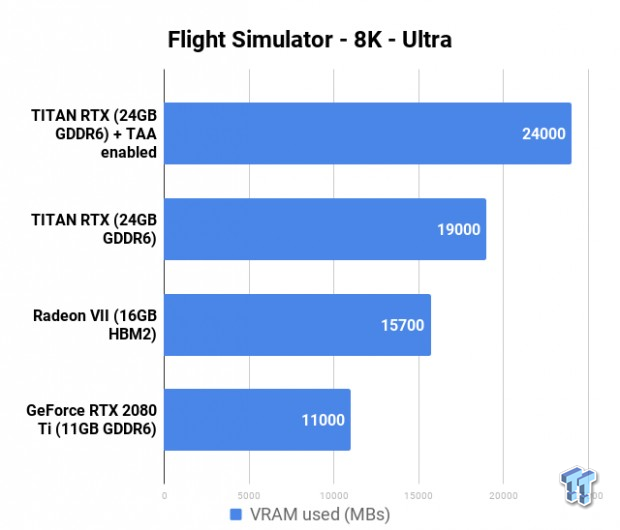
In the early testing, we're seeing right up to 16-17GB of VRAM being used at 8K. This is absolutely insane, and even with reduced graphics settings we're easily using 16-17GB of VRAM at 8K. But once everything is loaded in, and you're flying over a larger city or rendering more of the world -- 16-17GB VRAM is consumed.
But hey, I wouldn't be who I am if I didn't turn on some anti-aliasing and have a play -- VRAM consumption spiked up to an eye-boggling 24GB. Yeah, it was using everything the TITAN RTX could give.
NVIDIA's gigantic TITAN RTX has 24GB of GDDR6 and a huge $2499 price tag, but it handles it.
I could not run any other graphics card through this -- even the mighty, and flagship Turing-based GeForce RTX 2080 Ti was incapable of running Flight Simulator at 8K. Well, I guess it did technically run Flight Simulator... but the RTX 2080 Ti was barely capable of handling 1FPS at 8K.
Final Thoughts
Flight Simulator is an amazing feat, a synergy of real-time weather, mapping systems, next-gen graphics, the use of the cloud in a big way -- pushing every part of your gaming PC to its limits.

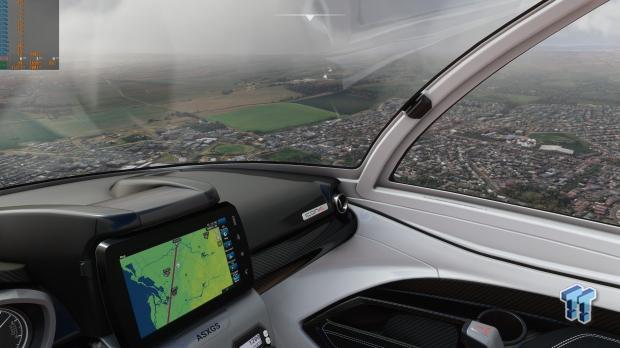
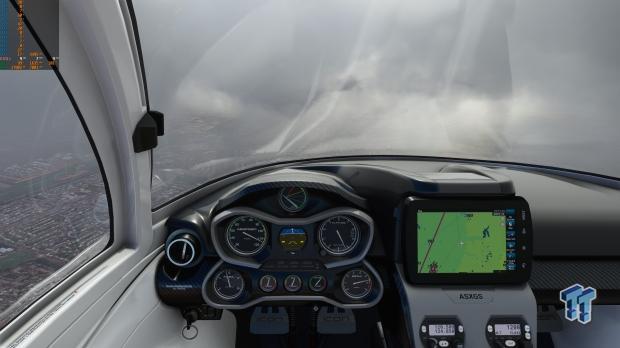
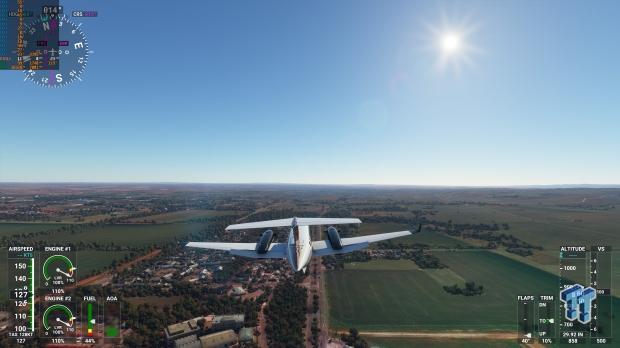
I was using an Intel Core i7-8700K @ 5GHz mixed with the very best graphics cards money can buy, and we're still not easily hitting 30FPS at 8K. You will also see limitations running high resolutions with RAM consumption, where I noticed it would easily consume over 16GB of system RAM, too.
So we're talking about let's call it an even 16GB of VRAM required, on average (in early testing), at 8K -- as well as over 16GB of system RAM (so be sure to have at least 32GB of RAM in your system). That's a hell of a lot of hardware, I don't remember the last time I ran a game that was using that much of each part of my system.
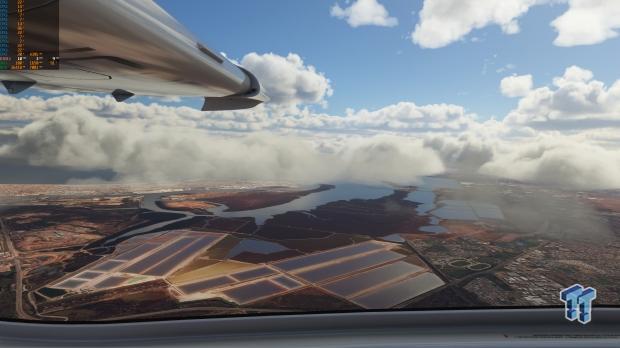
Flight Simulator was also spreading out nicely across my 12 threads of CPU at 5GHz, but I'm going to shift over to my Core i9-9900K and Ryzen 7 3800X systems in the coming days to see how the performance scales on those CPUs at 8K.
- Now, should I run 16K? This is a question I quickly asked myself during the testing, so I thought why the hell not -- you can drive the slider on the render scaling to 200% which when you're running a native 8K -- will provide you with 200% of that resolution: 16K.
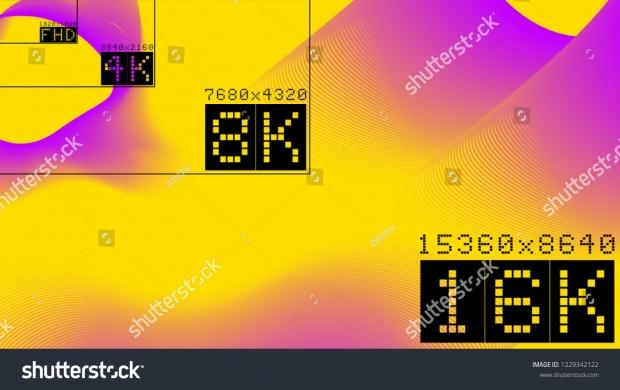
16K is pretty bonkers at a resolution of 15,360 x 8640, which is a truly out-of-this-world 132 million pixels -- up from the 33 million pixels of 8K and 8 million pixels of 4K. We can't even do native 16K right now, as we need DisplayPort 2.0 which will bring with it, support for 1 x 16K @ 60Hz display.
- What about triple-monitor 4K? This is something I'm going to spend a few days on; setting up, playing, and tweaking around with triple 4K monitors. In particular, 3 x 43-inch 4K 120Hz gaming monitors that will be absolutely perfect to immerse ourselves in Flight Simulator. Expect that article in the next few days.
- We need more GPU grunt: This is where NVIDIA's next-gen GeForce RTX 3090 graphics card, and its 40-50% performance jump over the GeForce RTX 2080 Ti would come in handy. So would that huge 24GB of GDDR6X memory that is clocked at a much higher 21Gbps, it would be a game changer for Flight Simulator at 8K. The same goes for RDNA 2, which is right around the corner -- re-testing will happen when those cards launch.
- VRAM requirements 8K: You need to have 16GB of VRAM minimum, to enjoy 8K gaming in Flight Simulator. This limits you to the AMD Radeon VII, with its Vega 20 GPU and 16GB of HBM2 memory, and then NVIDIA's monster TITAN RTX with 24GB of GDDR6. We really need next-gen graphics cards, now.

Wrapping Up
Where to from here? Weeks of testing with different graphics cards, multiple monitors, different CPU + GPU combinations, and system RAM amounts. I could probably even play with load times with storage and getting the game pumping away at 8K but it would take too much time.
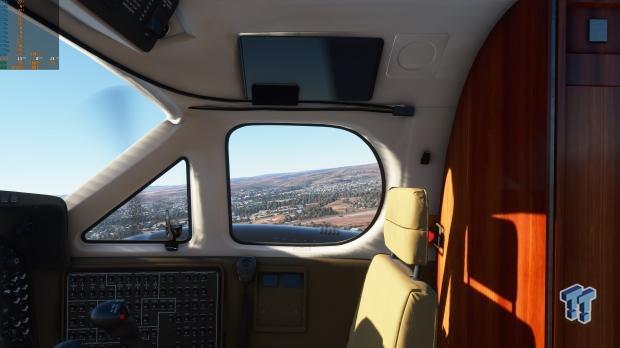
What I love about Flight Simulator, is we have game that stresses each part of your PC -- including your internet connection. If you want the best experience in Flight Simulator, you require a 50Mbps internet connection minimum. I have a 500Mbps pipe here, so I was fine thankfully.
But seeing it push past 16GB of system RAM and 24GB of VRAM within 60 seconds just blew my mind, I love seeing those types of strain on my gaming PC... it's how it should be.
Microsoft and Asobo have knocked it out of the park with Flight Simulator so far, but now it has driven me to set away the next 2-3 days to test out some triple-monitor 43-inch 4K 120Hz geek-glory.
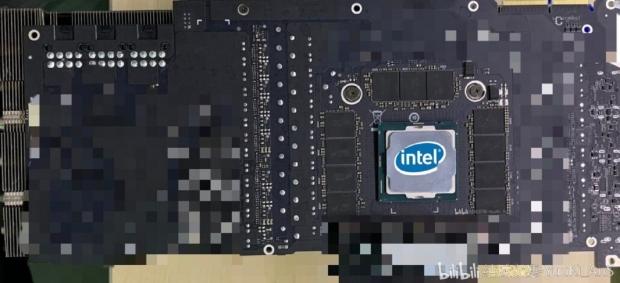
Utterly incredible, Flight Simulator is something truly next-generation... especially in 8K. But now we need that next-gen GeForce RTX 3090 graphics card and its super-powered Ampere GPU and 24GB of ultra-fast GDDR6X memory at 21Gbps pumping away at 1TB/sec memory bandwidth.
Or how about that 'NVIDIA Killer' RDNA 2-powered next-gen Radeon from AMD? Both companies are about to launch next generation graphics cards that will be required to run Flight Simulator at 4K 60FPS+ with everything on Ultra, or begin to even contemplate getting anywhere near 45-60FPS average at 8K on a next-gen graphics card.
What a rush -- see you guys in the next article: Flight Simulator tested on triple-monitor 4K monitors at 11,520 x 2160. Back into the skies I go.

